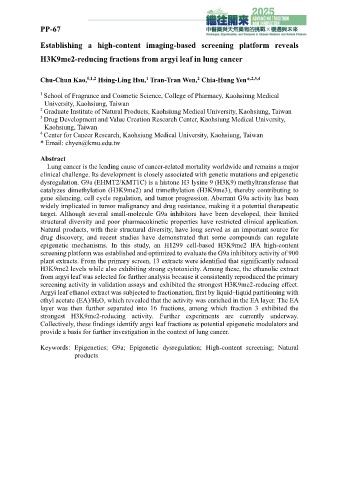Page 250 - 2025中醫藥與天然藥物聯合學術研討會-中醫藥與天然藥物的挑戰X機遇與未來大會手冊
P. 250
PP-67
Establishing a high-content imaging-based screening platform reveals
H3K9me2-reducing fractions from argyi leaf in lung cancer
2
1
Chu-Chun Kao, #,1,2 Hsing-Ling Hsu, Tran-Tran Wen, Chia-Hung Yen* ,2,3,4
1 School of Fragrance and Cosmetic Science, College of Pharmacy, Kaohsiung Medical
University, Kaohsiung, Taiwan
2 Graduate Institute of Natural Products, Kaohsiung Medical University, Kaohsiung, Taiwan
3 Drug Development and Value Creation Research Center, Kaohsiung Medical University,
Kaohsiung, Taiwan
4 Center for Cancer Research, Kaohsiung Medical University, Kaohsiung, Taiwan
* Email: chyen@kmu.edu.tw
Abstract
Lung cancer is the leading cause of cancer-related mortality worldwide and remains a major
clinical challenge. Its development is closely associated with genetic mutations and epigenetic
dysregulation. G9a (EHMT2/KMT1C) is a histone H3 lysine 9 (H3K9) methyltransferase that
catalyzes dimethylation (H3K9me2) and trimethylation (H3K9me3), thereby contributing to
gene silencing, cell cycle regulation, and tumor progression. Aberrant G9a activity has been
widely implicated in tumor malignancy and drug resistance, making it a potential therapeutic
target. Although several small-molecule G9a inhibitors have been developed, their limited
structural diversity and poor pharmacokinetic properties have restricted clinical application.
Natural products, with their structural diversity, have long served as an important source for
drug discovery, and recent studies have demonstrated that some compounds can regulate
epigenetic mechanisms. In this study, an H1299 cell-based H3K9me2 IFA high-content
screening platform was established and optimized to evaluate the G9a inhibitory activity of 900
plant extracts. From the primary screen, 13 extracts were identified that significantly reduced
H3K9me2 levels while also exhibiting strong cytotoxicity. Among these, the ethanolic extract
from argyi leaf was selected for further analysis because it consistently reproduced the primary
screening activity in validation assays and exhibited the strongest H3K9me2-reducing effect.
Argyi leaf ethanol extract was subjected to fractionation, first by liquid–liquid partitioning with
ethyl acetate (EA)/H₂O, which revealed that the activity was enriched in the EA layer. The EA
layer was then further separated into 16 fractions, among which fraction 3 exhibited the
strongest H3K9me2-reducing activity. Further experiments are currently underway.
Collectively, these findings identify argyi leaf fractions as potential epigenetic modulators and
provide a basis for further investigation in the context of lung cancer.
Keywords: Epigenetics; G9a; Epigenetic dysregulation; High-content screening; Natural
products

